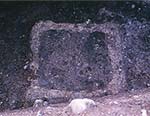Silver grain of a high degree of purity excavated in Dashitsuchidani District
The size is 1.8 x 1.2 cm, 0.6 cm thick and it weighs 5.95 g. Through a non-destructive analysis, calcium as well as lead and copper have been detected on it. It is most probably Haifuki Silver.
|
Collecting samples for analysis
 Samples are carefully collected from the remains. (A lees pit in Obegadani District)
Samples are carefully collected from the remains. (A lees pit in Obegadani District)
|
The remains of a square furnace discovered in Takeda District
Only the lower structure with a width of 45 x 55 cm surrounded by clay walls remains. Analyses of the inside soil show a high percentage of silver, lead, calcium and phosphorus. Numerous white bone fragments were also present. It is highly probable to have been a Haifuki furnace. |
Meeting for the scientific study
The meeting for the scientific study is held once a year to examine the results of the investigations together with researchers of various fields. |
Three-dimensional survey in Obegadani District
As the Mine Ruins extend widely and have many dangerous places such as galleries and shafts, the surveying methods should be carefully chosen. The survey method using laser beams to provide 3-D pictures is tentatively performed.
|
|

